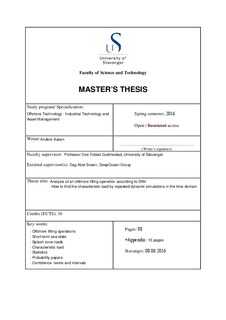| dc.contributor.author | Aasen, Anders | |
| dc.date.accessioned | 2016-09-28T08:53:43Z | |
| dc.date.available | 2016-09-28T08:53:43Z | |
| dc.date.issued | 2016-06-08 | |
| dc.identifier.uri | http://hdl.handle.net/11250/2411207 | |
| dc.description | Master's thesis in Offshore technology: industrial asset management | nb_NO |
| dc.description.abstract | In order to analyze a lift offshore performed from a vessel, focus is often put on preparing a good model of the main lifted object, the vessel motions (RAOs), the crane characteristics plus the sea state characteristics. However, something that is not so often put into focus is how to find the correct characteristic load that is affecting the object based on statistical data.
Usually, an irregular sea state is used when analyzing lifts at sea. In this thesis, a consideration of an object launch through the splash zone in a defined sea state has been analyzed. The resulting hydrodynamic forces in such a case are highly dependent on the timing with the incoming wave and the vessel motions. Therefore, several simulations of the same situation need to be performed in order to see the resulting characteristic load based on statistics.
In the industry today, there has not been established a standardized way of finding such a characteristic load. Neither has it been accurately determined what an acceptable probability of non-exceedance should be, or how statistical confidence is to be determined, meaning how many simulations that is sufficient to reproduce a result within a given accuracy.
DNV RP-H103 (2014) shows how the characteristic load can be determined from repeated time-domain simulations if the loads are Rayleigh distributed. In this thesis; the main case of a ROV lift performed by a LARS (Launch and Recovery System) arrangement are considered to cover a typical light lift scenario offshore. The simulation software Orcaflex has been used for the dynamic lifting analyses, while Excel has been used to analyze the statistical results using probability distributions. The non-linear effects such as slamming and drag forces and the short duration of the simulations are governing keys to explain the resulting extreme value load distributions.
The calculated results reveal that given repeated dynamic simulations for lifting operations offshore in a short term sea state does:
1. The most extreme loads experienced not always follow a Gumbel distribution and that the tail region given the use of probability papers should be considered;
2. The given characteristic loads may have a large statistical scatter depending on the simulation size, and;
3. Given the DNV standard regulations where a probability of structural failure should be less than 1 per 10000 lifting operations (DNV-OS-H101, 2011, Section 1, A201), large sample/simulation sizes are required in order to get a high level of confidence. A second criterion has therefore been proposed for implementation. | nb_NO |
| dc.language.iso | eng | nb_NO |
| dc.publisher | University of Stavanger, Norway | nb_NO |
| dc.relation.ispartofseries | Masteroppgave/UIS-TN-IKM/2016; | |
| dc.subject | driftledelse | nb_NO |
| dc.subject | offshore teknologi | nb_NO |
| dc.subject | offshore lifting operations | nb_NO |
| dc.subject | short term sea state | nb_NO |
| dc.subject | splash zone loads | nb_NO |
| dc.title | Analysis of an offshore lifting operation according to DNV - How to find the characteristic load by repeated dynamic simulations in the time domain | nb_NO |
| dc.type | Master thesis | nb_NO |
| dc.subject.nsi | VDP::Technology: 500::Marine technology: 580::Offshore technology: 581 | nb_NO |
